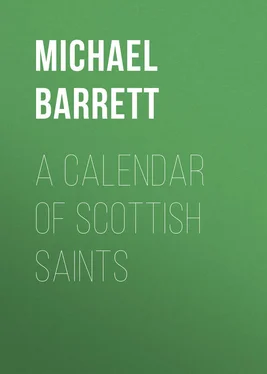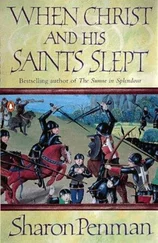Michael Barrett - A Calendar of Scottish Saints
Здесь есть возможность читать онлайн «Michael Barrett - A Calendar of Scottish Saints» — ознакомительный отрывок электронной книги совершенно бесплатно, а после прочтения отрывка купить полную версию. В некоторых случаях можно слушать аудио, скачать через торрент в формате fb2 и присутствует краткое содержание. Жанр: foreign_antique, foreign_prose, на английском языке. Описание произведения, (предисловие) а так же отзывы посетителей доступны на портале библиотеки ЛибКат.
- Название:A Calendar of Scottish Saints
- Автор:
- Жанр:
- Год:неизвестен
- ISBN:нет данных
- Рейтинг книги:5 / 5. Голосов: 1
-
Избранное:Добавить в избранное
- Отзывы:
-
Ваша оценка:
- 100
- 1
- 2
- 3
- 4
- 5
A Calendar of Scottish Saints: краткое содержание, описание и аннотация
Предлагаем к чтению аннотацию, описание, краткое содержание или предисловие (зависит от того, что написал сам автор книги «A Calendar of Scottish Saints»). Если вы не нашли необходимую информацию о книге — напишите в комментариях, мы постараемся отыскать её.
A Calendar of Scottish Saints — читать онлайн ознакомительный отрывок
Ниже представлен текст книги, разбитый по страницам. Система сохранения места последней прочитанной страницы, позволяет с удобством читать онлайн бесплатно книгу «A Calendar of Scottish Saints», без необходимости каждый раз заново искать на чём Вы остановились. Поставьте закладку, и сможете в любой момент перейти на страницу, на которой закончили чтение.
Интервал:
Закладка:
In 664 a terrible epidemic called the Yellow Plague visited Scotland and carried off numbers of the inhabitants. Boisil and Cuthbert were both attacked by the malady, and the lives of both were endangered. The holy prior, however, from the beginning foretold the recovery of Cuthbert and his own death. Summoning the latter to his bedside, he prophesied his future greatness, relating all that was to befall him in the years to come, and especially his elevation to the episcopal rank. Then he begged Cuthbert to assist him during the seven days of life which remained to him to finish the study of St. John's Gospel on which they had been engaged. In this they occupied themselves till St. Boisil's peaceful death.
The church of St. Boswell's was dedicated to this saint, the name is a corruption of St. Boisil's. The old town has disappeared. An annual fair was formerly held on July 18th, in honour of the saint. His well also was situated there.
25 – St. Cumine, Abbot, A.D. 669.
He was the seventh abbot of Iona, and his learning and holiness rank him among the most illustrious monks of that renowned monastery. The Synod of Whitby, which was instrumental in overthrowing the ancient Celtic computation of Easter and substituting the Roman use, occurred during Cumine's occupation of the abbacy. He wrote a life of St. Columba, probably to vindicate his sanctity after the apparent slight offered to his memory by the synod in setting aside the traditional usage which he had cherished. This life seems to have been the result of St. Colman's visit to Iona before his return to Ireland (see Feb. 18th).
A more important work is St. Cumine's letter on the Easter controversy, which he wrote before he became abbot, and which shows a thorough acquaintance with the difficulties of the subject, as well as deep knowledge of the Sacred Scriptures and writings of the Fathers. He is often called Cumine Ailbhe (Cumine the Fair-haired). His name survives in Kilchuimein (Church of St. Cumine), the ancient designation of Fort-Augustus, and the only name by which it is still called in Gaelic. A spot in the same neighbourhood is known as St. Cumine's Return; it is in the vicinity of a hill called St. Cumine's Seat. The parish church of Glenelg also is named after this saint.
MARCH
1 – St. Marnock or Marnan, Bishop, A.D. 625.
Like so many of the Celtic saints, the name of this one has been changed by the addition of particles expressive of reverence. The original form was Ernin; the Scottish name is a contraction of the Gaelic words Mo-Ernin-og (my little Ernin). He is considered by some writers to have been of Irish nationality, but this is by no means established. St. Marnock laboured as a missionary in Moray, being specially noted for his zeal in preaching. He died at Aberchirder in Banffshire, and was buried in the church there. The place after wards received the additional name of Marnock from its connection with the saint. St. Marnock's shrine became a favourite place of pilgrimage, and miracles were wrought through his relics, which were religiously preserved there. The head of St. Marnock was frequently borne in procession to obtain fair weather. It was the custom also to have lights placed round it every Sunday and to wash the relic with water, which was afterwards used, greatly to their benefit, by the sick. The Innes family, who chose the saint as their patron, had a particular devotion to that relic.
Traces of the cultus of St. Marnock are to be found in many districts of Scotland. Besides the church in which his remains were honoured, a holy well at Aberchirder still bears his name. A fair on the second Tuesday in March, held there annually, was known as Marnock Fair. There was a Marnock Fair at Paisley also, which lasted for eight days. The church of the well-known parish of Kilmarnock, in Ayrshire, is another of his dedications. Near Kilfinan, in Argyllshire, and not far from the sea shore, may be seen the foundation and a fragment of the wall of a chapel with a graveyard round it; the field in which the chapel stands is called Ard-Marnoc. On an eminence not far off is a cell which tradition assigns to this saint as a place of retirement for solitary communion with God. Inchmarnock, an island near Bute, is another place connected with him; Dalmarnock at Little Dunkeld, is named after this saint. Other churches and parishes also show traces of the honour paid to him in Catholic ages.
St. Monan, Martyr, 9th century.
According to some writers, he was one of the companions of St. Adrian (who was honoured on March 4), and preached the Gospel in Fifeshire; his relics being afterwards translated to Abercrombie in that county – King David II., in thanksgiving for cures obtained through the saint's intercession, erecting there a noble church to contain them. Dr Skene, however, is of opinion that this saint was not a martyr, but was St. Monan, Bishop of Clonfert, known in Irish calendars as Moinenn, and that his relics were brought to Abercrombie by Irish who had fled from the Danes then plundering and burning Irish monasteries about the year 841. On account of the great devotion of the saint, Abercrombie became generally known as St. Monan's, but has now reverted to its original title. The church was given by James III. to the Dominicans; later on it was transferred to the Canons Regular of St. Andrews. St. Monan's Well is near the ancient building.
2 – St. Fergna, Bishop, A.D. 622.
This saint, a fellow-citizen and relative of St. Columba, became eventually Abbot of Iona. During his rule many of the young nobles who had fled from the sword of the King of Deira took shelter in the monastery. They were instructed and converted to the Christian Faith. St. Fergna is said to have been made a bishop in the later years of his life, but this is called in question by some writers. He seems to have been of partly British descent and is often styled "Fergna the Briton."
4 – St. Adrian and Companions, A.D. 875.
An old legend, which was long regarded as authentic, relates that this saint was of royal birth and was a native of Hungary, and that he came to Scotland with several companions to preach the Faith. Modern historians identify him with the Irish St. Odhran, who was driven from his country by the Danes and took refuge in Scotland. He preached the Gospel to the people of Fifeshire and the eastern counties. Eventually he founded a monastery on the Isle of May in the Firth of Forth. Here he suffered martyrdom, together with a great number of his disciples, in an incursion of the Danes. A Priory was built on the island by David I, and placed under the Benedictine Abbey of Reading. Later on it was given over to the Canons Regular of St. Andrews. The Isle of May became a famous place of pilgrimage on account of the connection with it of other saints besides St. Adrian and his companions. James IV visited it several times, having evidently a great affection for the holy place. In 1503 he took the "clerkis of the Kingis chapell to Maii to sing the Mes thair." Other records occur in his treasurer's accounts, such as the following: "To the preistis to say thre trentals of Messis thair"; for "the Kingis offerand in his tua candillis in Maii."
6 – St. Baldred, Hermit, A.D. 608.
This saint, according to a popular tradition, was a disciple of the great St. Kentigern. He has often been styled the Apostle of East Lothian. After his master's death St. Baldred took up his residence upon the Bass Rock, near North Berwick, and there he devoted himself to penance and prayer, his favourite subject of meditation being the Passion of Christ Our Lord. From time to time he would pay missionary visits to the mainland. He died at Aldhame in Haddington, a village which has now disappeared; St. Baldred's Cave is on the sea-shore near its former site. Tyningham Church, in the same county, and also that of Prestonkirk, were dedicated to him. The former was burnt by the Danes in 941. The old parishes of Aldhame and Tyningham are now united under the designation of Whitekirk. At Prestonkirk there is a well which bears the saint's name, whose water, as a Protestant writer notes, is excellent for making tea! An eddy in the Tyne is called St. Baldred's Whirl. A century ago Prestonkirk churchyard possessed an ancient statue of St. Baldred. The ruins of a chapel dedicated to the saint are still discernible on the Bass Rock.
Читать дальшеИнтервал:
Закладка:
Похожие книги на «A Calendar of Scottish Saints»
Представляем Вашему вниманию похожие книги на «A Calendar of Scottish Saints» списком для выбора. Мы отобрали схожую по названию и смыслу литературу в надежде предоставить читателям больше вариантов отыскать новые, интересные, ещё непрочитанные произведения.
Обсуждение, отзывы о книге «A Calendar of Scottish Saints» и просто собственные мнения читателей. Оставьте ваши комментарии, напишите, что Вы думаете о произведении, его смысле или главных героях. Укажите что конкретно понравилось, а что нет, и почему Вы так считаете.












